 The Saints John The Saints John
An Address given by WBro Nigel Friggens, SD, on behalf of The Hawke’s Bay Research Lodge No 305 to
The Woburn Lodge No 25 in Waipukurau on 14th October 2010
This is my maiden Masonic lecture. Being a schoolteacher you might assume that I am used to giving lectures but, if you know anything about modern educational practice, you should more properly expect me to dish out work sheets or split you up into discussion groups. Being an IT teacher, I know a lot about the dangers of research on the Internet and the importance of verifying sources. Did you know, for instance that if you drill down deep enough into the martinlutherking.org site you will eventually discover that a white supremacist group sponsors it? You get interesting essays back from kids who use that site as their sole reference.
I have just completed a 4-year theological study. The main thing I learnt was how much I still have to learn! I know even less about freemasonry, despite being raised ten years ago.
Tonight I am going to refer to the Saints John, but I suspect that in other orders, there is quite a lot said about one or both of these characters that I know nothing of. Apologies to you if I get it wrong.
However, in the spirit of enquiry I wanted to learn about why St John the Baptist and St John the Evangilist have been historically important figures in Masonic lore. I found out that the Saints John were commonly referred to as the “Two Great Parallels” – St John the Evangelist completing by his learning what St John the Baptist had begun by his zeal.
That’s interesting because"On the front of the altar supporting the VSL is a circle with a dot in the middle. From the 'Explanation of the First Tracing Board' in our NZ rituals: -
"In all regular Lodges there is a point within a circle from which a Freemason cannot err. This circle is bounded by two great parallel lines”
 We are taught as Entered Apprentice Freemasons that one perpendicular parallel line represents Moses, and the other King Solomon. We are further taught that the VSL rests at the top of the circle bounded by those lines. Exactly what the point in the centre of the circle really means is the subject of another lecture. We are taught as Entered Apprentice Freemasons that one perpendicular parallel line represents Moses, and the other King Solomon. We are further taught that the VSL rests at the top of the circle bounded by those lines. Exactly what the point in the centre of the circle really means is the subject of another lecture.
The First Degree leaves us in doubt as to what it actually represents, but in tracing backwards in time I found out that, until comparatively recent times, the two parallel lines represented the patron saints of Freemasonry - St. John the Baptist and St. John the Evangelist.
Why this change occurred is undoubtedly the subject of a third lecture.
The main lecture I am giving tonight has been unashamedly sourced from a paper, written by WBro Harvey L Ward Jr, PM of R.T. Schafer Lodge No. 350, F&AM Grand Lodge of Florida, USA, entitled "...AND DEDICATED TO THE HOLY SAINTS JOHN - An inquiry into the designation of the Saints John as Patron Saints of Freemasonry”
You can read the full text on
http://www.freemasons-freemasonry.com/ward.html
Or just google St John and Masonry. The lecture was first given on the occasion of Saint John the Baptist’s Day, June 24, 2000.
Brother Ward begins…
One of the primary purposes of Freemasonry is the education of its members. Unfortunately, as the pressures of time and business conspire to constrain the intellectual activity of our Lodges, real Masonic education and inquiry are among the first pursuits to be jettisoned from our regular agendas. Education and reflection on Masonic issues used to be much more of a central part of a Masonic Lodge than it is today
Too often we become “parrot Masons” - Masons who become quite proficient at learning words and directions but who give little or no attention to the philosophy behind those words.
That, incidentally, is the reason why I have joined the Lodge of Research and I would encourage others to do so. To be true to my principles I have to do some research even if it is just a matter of Internet searching and checking.
Brother Ward continues…
All of our Blue Lodges were dedicated to the Holy Saints John, yet we never hear any other information regarding these “Holy Saints John” or anything to explain why they were referred to as the Patron Saints of Freemasonry.
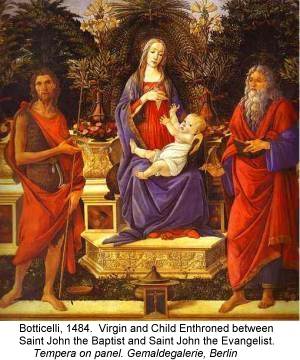
Who were these Saints John? What are they to us as Freemasons? In early Masonry, the feast day of St. John the Baptist was always celebrated by the Craft. In fact, the first public Grand Lodge, the Grand Lodge of England, was born on St John the Baptist’s day, June 24 1717, in London. Thereafter, the Grand Lodge of England sponsored great annual celebrations of this day for many years.
Eventually the feast of St John the Evangelist became important as well and many Lodges moved the beginning of their Masonic year from June 24 (St John the Baptist’s feast day) to December 27(St John the Evangelist’s feast day). These festival days were of central importance to early American Lodges as well.
All well-governed early Lodges almost always celebrated both feast days. Records indicate that Brothers George Washington and Benjamin Franklin always made it a point to attend their Lodges respective observances of St Johns Days. Elections and installations were usually planned around these dates.
We always run the danger of allowing traditions to become habits and losing sight of the reason for the original tradition. Today we celebrate the festival, or feast day of St. John the Baptist.
Who was Saint John the Baptist? The four (Christian) Gospels, the Books of Matthew, Mark, Luke and John, as found in the Bible’s New Testament, all describe this man in almost exactly the same language. The Baptist, who was a cousin to Jesus Christ, is spoken of as “A voice crying in the wilderness,” whose purpose was to, “Prepare the way of the Lord and make his paths straight.”
He must indeed have been an important man for all four Gospels to refer to him with exactly the same terminology. In the Gospel of Luke, in fact, Jesus himself says of John, “Among them that are born of women, there has not risen any greater than John the Baptist.” High praise indeed! It becomes clearer why we as Masons should hold him in such esteem.
John the Baptist (called the Baptist because as he preached he baptised believers in the River Jordan) lived a simple, yet powerful and devout life. He preached single-minded righteous living and change of character. His message was that one must live in a holy manner and that deviation from that manner was not acceptable. For his refusal to change himself or his message and for his devotion to Jesus, John the Baptist was imprisoned and eventually beheaded by King Herod. The heroism, fidelity and integrity of John are echoed in the legend of Hiram Abif, which gives us more insight into his choice as a Patron Saint of the Masonic Order.
Saint John the Evangelist is important to us as Masons as well – who was he? While we have a relatively concrete biography of St. John the Baptist, whose theology and teachings were straightforward and rigid, the story of the Evangelist is more difficult to relate and requires more study, much like his teachings. Saint John the Evangelist is likely the amalgamation of several New Testament Johns, including John the Disciple of Christ, John the Epistle writer and John the Divine of Patmos, the author of the Book of Revelation.
There are many striking reasons why early Freemasons would choose the Evangelist as Patron. Chiefly, the writings of this John (or group of Johns) read almost like Masonic ritual. The Gospel of John begins:
In the beginning was the Word, and the Word was with God and the Word was God. The same was with God. All things were made by him; and without him was not any thing made that was made. In him was life; and the life was the light of men. And the light shineth in darkness; and darkness comprehended it not.
Nowhere else in the Bible since the beginning of Genesis (familiar to all Freemasons) is the concept of light so entwined with the idea of the divine spirit. John the Evangelist leads us forward in the direction of considering the Word, the Light and the Divine as inseparable parts of the whole of Creation. In his Epistles, the Evangelist continues the theme that the Word and the Light are inevitably linked and goes on to bring Truth and Love in as links of the same chain. The idea and practice of Brotherly Love and Fellowship is explored more thoroughly by the Evangelist than by any other New Testament writer. The disturbing imagery of the Book of Revelations is the source of many esoteric schools of thought and many writers have made convincing arguments that this imagery is in many ways influential to Masonry.
There we have two Saints John, very properly described masonically as parallel figures - both of unimpeachable character and strong influence on the Western Mind, but one dogmatic and rigid, and the other intellectual and esoteric. In both we find the integrity and inflexible fidelity so common to Masonic teaching, but the manner of teaching those virtues varies between the two. It is fitting that they represent these parallel lines of which we speak.
But why them? Have they always been linked to the Fraternity?
This brings us to the question of whence comes our Masonry?
Interestingly, all three traditions of the most common theories of Masonic origins have their own relationship with the Saints John.
Firstly there is a school of Masonic research holding that the Fraternity is descended from the Druids and other truly ancient Celtic priesthoods of the sun.
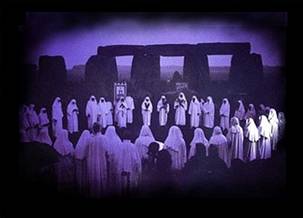
Implausible as this theory is, it has a direct correlation to the veneration of the Saints John. Although entirely pagan and pre-Christian, these sun priests claimed as their holiest days the summer and winter solstices, the day when the sun shines the most and the day when it shines the least. As this was common among many pagan theologies, the early and medieval Christian Church adopted the solstices as important feast days and simply renamed them for two of the most important saints.
The summer solstice was officially fixed to June 24 and dedicated to St. John the Baptist and the winter solstice was fixed to December 27 and dedicated to St. John the Evangelist.
Celebration of the solstices can be viewed as the embodiment of the Masonic ideals of regularity, constancy and order. As Freemasons we naturally work toward order and against irregularity and chaos. What better example of order and regularity than these diurnal solstices when the sun inevitably “dies” and is “reborn”? As the early Church saw wisdom in adopting these pagan symbols, perhaps it is not such a leap of faith to see them as Masonic Symbols as well.
Secondly, the long-held belief that modern Masonry evolved from Medieval Stonemason Guild. Regardless of the veracity of this belief, there is a relationship with the Saints John from this theory as well.
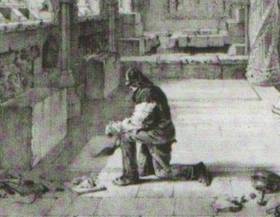
Of course, all medieval guilds adopted Patron Saints and used their feast days as central gatherings for celebration and also for choosing leaders and other necessary business matters. Stonemason Guilds, most notably in northern England and Scotland, often chose one or both of the Saints Johns as their Patrons.
The Freemasonry we practice here today came primarily from northern England and Scotland where the Saints John were common among the Stonemason Guilds.
The third theory of Masonic genesis that our Freemasonry evolved from the knightly orders of the Crusades - specifically named are the Knights Templars and to a lesser extent the Knights Hospitaller.
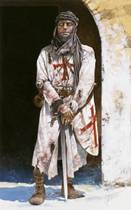
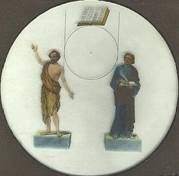
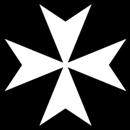 It is important to note here that the Hospitallers were (and are still today) more properly known as the Knights of St. John. It is important to note here that the Hospitallers were (and are still today) more properly known as the Knights of St. John.
The Saints John are also commonly referred to in Templars records and we know their festival days were of importance to the Templars. Also important in this inquiry is that one of the charges of “heresy” brought against the Templars was that they had become followers of Gnostic Christianity and had in many ways left behind the more traditional Roman Catholic interpretations.
This is important in a discussion of the Saints John because the basis of much Gnostic thought is the Gospel and Epistles of John the Evangelist. In effect, the “crimes” of the Templars may have been that they venerated the theology of Saint John the Evangelist more than that of Saint Paul or Saint Peter.
While we can find no real answers to the question of why the Saints John are our Patrons, the lineage of the dedication is clear. As Freemasons perhaps we should view the Saints John symbolically as the perfect form or ideal of Masons. Although we know they were not Freemasons, what we know of them shows them to be perfect examples of what a Freemason should be: kind, righteous, loving and above all faithful unto death to the trust reposed in him. They are the Platonic Form of the Freemason never to be achieved, but always to be emulated.
While we have now no more answers on this subject than when we started, we have hopefully shed a little more light or truth, as the Evangelist would see it on the practice of dedicating Lodges to the Holy Saints John. As always in Masonry, every revealment is also a revelation and we must always in new knowledge meet new intellectual frustrations. Freemasonry is, after all, the legend of the search for the Lost Word and we are charged to be the searchers. Hopefully this inquiry ignites some interest in further research and makes the observance of Saint Johns Day a little more poignant for us as Masons.
Certainly when I look at the parallels in my lodge I will recall St John the Evangelist (the learned, esoteric intellectual) and St John the Baptist (the rigid moralist) and I might even categorise my brethren accordingly.
***********************
Bibliography:
Ward, Harvey L Jr, And Dedicated to the Holy Saints John
http://www.freemasons-freemasonry.com/ward.html
The graphics are from various sources.
This lecture was delivered using a computer presentation package called prezi.com.
|

